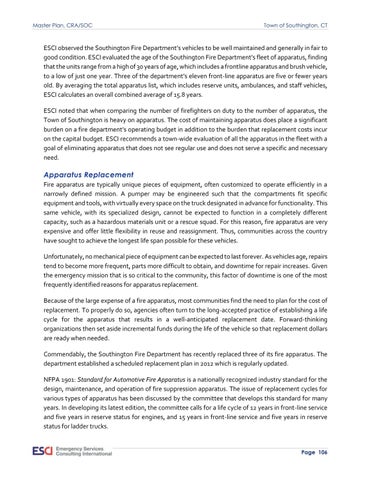Master Plan, CRA/SOC
Town of Southington, CT
ESCI observed the Southington Fire Department’s vehicles to be well maintained and generally in fair to good condition. ESCI evaluated the age of the Southington Fire Department’s fleet of apparatus, finding that the units range from a high of 30 years of age, which includes a frontline apparatus and brush vehicle, to a low of just one year. Three of the department’s eleven front-line apparatus are five or fewer years old. By averaging the total apparatus list, which includes reserve units, ambulances, and staff vehicles, ESCI calculates an overall combined average of 15.8 years. ESCI noted that when comparing the number of firefighters on duty to the number of apparatus, the Town of Southington is heavy on apparatus. The cost of maintaining apparatus does place a significant burden on a fire department’s operating budget in addition to the burden that replacement costs incur on the capital budget. ESCI recommends a town-wide evaluation of all the apparatus in the fleet with a goal of eliminating apparatus that does not see regular use and does not serve a specific and necessary need.
Apparatus Replacement Fire apparatus are typically unique pieces of equipment, often customized to operate efficiently in a narrowly defined mission. A pumper may be engineered such that the compartments fit specific equipment and tools, with virtually every space on the truck designated in advance for functionality. This same vehicle, with its specialized design, cannot be expected to function in a completely different capacity, such as a hazardous materials unit or a rescue squad. For this reason, fire apparatus are very expensive and offer little flexibility in reuse and reassignment. Thus, communities across the country have sought to achieve the longest life span possible for these vehicles. Unfortunately, no mechanical piece of equipment can be expected to last forever. As vehicles age, repairs tend to become more frequent, parts more difficult to obtain, and downtime for repair increases. Given the emergency mission that is so critical to the community, this factor of downtime is one of the most frequently identified reasons for apparatus replacement. Because of the large expense of a fire apparatus, most communities find the need to plan for the cost of replacement. To properly do so, agencies often turn to the long-accepted practice of establishing a life cycle for the apparatus that results in a well-anticipated replacement date. Forward-thinking organizations then set aside incremental funds during the life of the vehicle so that replacement dollars are ready when needed. Commendably, the Southington Fire Department has recently replaced three of its fire apparatus. The department established a scheduled replacement plan in 2012 which is regularly updated. NFPA 1901: Standard for Automotive Fire Apparatus is a nationally recognized industry standard for the design, maintenance, and operation of fire suppression apparatus. The issue of replacement cycles for various types of apparatus has been discussed by the committee that develops this standard for many years. In developing its latest edition, the committee calls for a life cycle of 12 years in front-line service and five years in reserve status for engines, and 15 years in front-line service and five years in reserve status for ladder trucks.
Page 106












